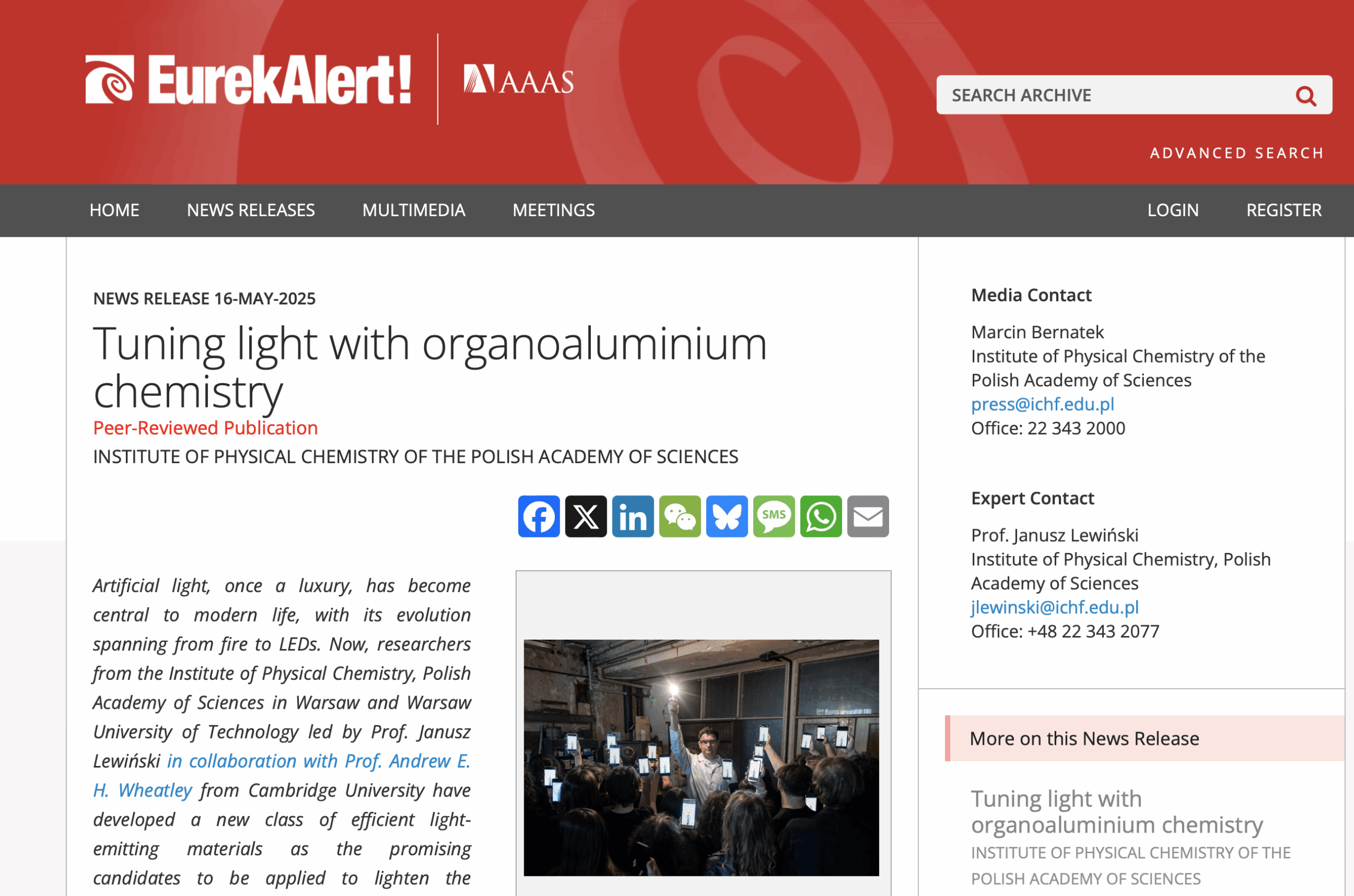
National Science Centre’s OPUS13 project No. 2020/37/B/ST4/03310
Hypervalancy, dormant Lewis acidity and relationship between non-covalent interactions in the Group 13 organometallics (HYPE-13)
Project leader: Iwona Justyniak, PhD Eng
Project duration: February 2021 – January 2024
Project value: PLN 1 252 800 (ca. EUR 0.3 million)
PROJECT DESCRIPTION PAPERS DISSEMINATION RECRUITMENT
Project description
Group 13 organometallic complexes are of fundamental and practical importance due to their remarkable structural diversity and versatility in applications. Moreover, aluminum alkyls are often considered as exemplary compounds of main group organometallics and Me3Al is the World record holder for the most common organometallic compound produced commercially in terms of tonnage. Hence, attempts to gain an in-depth understanding of the multi-faceted chemistry of Group 13 organometallics are continually vital for the development of new reagents and catalyst or building units for modern functional materials. A large number of studies have been directed to better understand the factors controlling the formation and stability of Group 13 higher coordinate organoaluminium complexes but none of them offers a comprehensive view on the subject. The essence of electron-rich three-center bonding is a hot topic for decades and the lack of a uniform concept of hypervalency in Group 13 compounds leads to many misinterpretations even in some general chemistry textbooks or respectable journals.
Despite extensive research in the field, there is still relatively limited knowledge of the factors tuning both the reactivity of octet-compliant complexes and the stability of higher coordinated complexes. Previously, in the course of our comprehensive studies on the multi-faceted chemistry of mononuclear and multinuclear Group 13 metal carboxylates we have made attempts to rationalize the tendency of octet-compliant complexes involving highly polarized bonds to form higher coordinated adducts with a wide range of neutral donor ligands, introducing the concept of dormant Lewis acidity as heuristically useful categorization of this phenomenon. More recently, this novel concept was extended and introduced to so-called poly-Lewis acids resulted and termed these new systems as dormant poly-Lewis acids in regard to metal complexes containing multiple dormant Lewis acid sites. Another challenge ahead concerns the role of non-covalent interactions in the chemistry of Group 13 organometallics. The second-sphere noncovalent interactions often operate in concert with the primary donor-acceptor bonds, which provides opportunities for the rational manipulation of the structure of metal complexes and intentional control over stabilization of reactive species.
With this background, the general objective of HYPE-13 takes a number of the raised above challenging issues and encompasses theoretical and experimental investigations directed toward the factors controlling the structure and reactivity of various types of Group 13 organometallics to provide a framework for a unified look at both the dormant Lewis acidity and the bonding situation in electron-rich hypervalent molecules, and unraveling the role of non-covalent interactions on the properties of the complexes in question. We believe that the project and the acquired knowledge will provide strong bases for further development of multi-faceted chemistry of Group 13 metal complexes.
Papers
- V. Szejko, I. Justyniak, M. Jędrzejewska, G. Jędrzejczyk, T.-L. Precht, A. Kubas, A. E. H. Wheatley, J. Lewiński
Luminescent Alkylaluminium Anthranilates Reaching Unity Quantum Yield in the Condensed Phase
Angewandte Chemie International Edition, 2025, 64, e202501985. WWW - W. Ziemkowska, V. Szejko, B. Prus, P. Socha, M. K. Cyrański, A. Jastrzębska, I. Justyniak
Synthesis of Carboxyalumoxanes through Well-Defined Organoaluminum and Organogallium Carboxylatohydroxides Obtained by Controlled Hydrolysis
Inorganic Chemistry, 2025, 64, 8981−899. WWW - A. Pietrzykowski, I. Justyniak, V. Szejko, T. Skrok, T. Radzymiński, K. Suwińska, J. Lewiński
A New Structural Motif in Aggregation of Methylalumoxanes: Non-hydrolytic Route Involving the Alkylation of Dicarboxylic Acids
Chemistry – A European Journal, 2024, 30, e202402021. WWW - K. Korona, I. Justyniak, J. Pogrebetsky, M. Lemieszka, P. Bernatowicz, A. Pietrzykowski, A. Kubas, J. Lewiński
Controlled hydrolysis of AlMe3 to tetramethylalumoxane and a new look at incipient adducts with water
Chemical Communications, 2024, 60, 9392–9395. WWW
Dissemination
Achievements of the project were disseminated through a press release published in the IChF press service and the EurekAlert! website.
Recruitment
Currently, there are no open positions in the project.
Earlier recruitments:
- 2 PhD Students [more info]
- Master Student [more info]
- Master Student [more info]
Deadline for online submissions: 17 March 2021, 5.00 PM CET (UTC+1).

